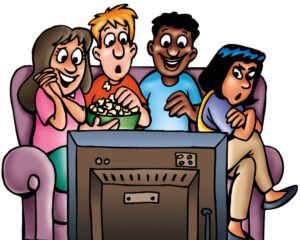Cartoon and Child Psychology
Cartoons can have a significant impact on child psychology and development. Here are some ways in which cartoons can influence children:
- Entertainment and Relaxation: Cartoons are a source of entertainment and relaxation for children. They provide a break from daily routines and can be a source of joy and amusement.
- Social and Emotional Development: Cartoons often depict social interactions and emotions. Children can learn about different emotions, how to express them, and how to deal with social situations by watching characters in cartoons.
- Imagination and Creativity: Cartoons often feature imaginative and fantastical worlds and characters. This can stimulate a child’s imagination and encourage them to be creative in their play and thinking.
- Language and Communication: Cartoons can help improve a child’s language skills. They expose children to new words, phrases, and concepts, which can enhance their vocabulary and communication skills.
- Moral and Ethical Lessons: Many cartoons include moral and ethical lessons. They often depict characters facing dilemmas and making choices, which can provide opportunities for discussions about right and wrong.
- Cultural Awareness: Cartoons from different cultures can introduce children to diverse perspectives and traditions. This can foster cultural awareness and tolerance.
- Educational Content: Some cartoons are designed specifically for educational purposes, teaching children about numbers, letters, science, and other subjects in an engaging and fun way.
However, it’s essential to note that not all cartoons are suitable for children, and excessive screen time can have negative effects. Parents and caregivers should be mindful of the content and duration of cartoon-watching, as well as the age-appropriateness of the material. Here are some considerations:
- Content Selection: Choose age-appropriate cartoons that align with your child’s developmental stage. Some cartoons may contain violence, inappropriate language, or themes that are not suitable for young children.
- Screen Time: Limit the amount of time your child spends watching cartoons. Excessive screen time can have adverse effects on physical health, sleep, and social interactions.
- Co-viewing: Watch cartoons with your child and engage in discussions about what they are watching. This allows you to monitor content and provide context or explanations when needed.
- Balanced Activities: Encourage a balance between screen time and other activities like outdoor play, reading, and creative play.
- Parental Controls: Use parental control features on streaming platforms and devices to restrict access to age-inappropriate content.
In summary, cartoons can play a role in child development, offering both entertainment and educational opportunities. However, it’s crucial for parents and caregivers to guide and monitor children’s cartoon consumption to ensure a positive and healthy viewing experience.
Benefits of Cartoons on Child Psychology
- Cognitive Development: Some cartoons are designed to be educational, teaching children about numbers, shapes, colors, and other basic concepts. Educational cartoons like “Sesame Street” have been shown to improve early literacy and math skills.
- Problem-Solving Skills: Many cartoons feature characters who face challenges and solve problems. Children can learn problem-solving strategies by observing how their favorite characters tackle various situations.
- Social Learning: Cartoons often depict social interactions, relationships, and conflicts. This can help children learn about empathy, cooperation, and conflict resolution by observing how characters interact with one another.
- Role Models: Positive and relatable cartoon characters can serve as role models for children. They may learn valuable life lessons, such as the importance of kindness, perseverance, and honesty from these characters.
- Emotional Regulation: Cartoons can help children understand and manage their emotions. When characters express emotions like anger, fear, or sadness, it can provide a framework for discussing and processing these feelings.
- Language Development: Exposure to a variety of language patterns and vocabulary through cartoons can enhance a child’s language development. It can also help with pronunciation and language comprehension.
Challenges of Cartoons on Child Psychology
- Content Quality: Not all cartoons are created equal. Some may contain violence, stereotypes, or inappropriate themes that are not suitable for children. Parents need to carefully select age-appropriate content.
- Excessive Screen Time: Spending too much time watching cartoons can lead to negative consequences, including sedentary behavior, reduced physical activity, and disrupted sleep patterns.
- Commercialization: Many cartoons are associated with merchandise and consumer products. Children may be influenced to request or desire these products, which can create challenges for parents.
- Attention Span: Excessive exposure to fast-paced cartoons can potentially shorten a child’s attention span and make it more challenging for them to focus on slower-paced, real-world activities.
- Social Interaction: Excessive screen time, including watching cartoons, can limit opportunities for face-to-face social interactions, which are essential for social development.
- Overstimulation: Some cartoons are highly stimulating, with flashing lights and rapid visual and auditory changes. This can overwhelm young children and contribute to sensory issues.

Guidelines for Healthy Cartoon Consumption
To ensure that cartoons have a positive influence on child psychology, parents and caregivers can follow these guidelines:
- Select Age-Appropriate Content: Choose that are suitable for your child’s age and maturity level.
- Limit Screen Time: Set daily time limits for cartoon-watching and encourage a balance between screen time and other activities.
- Co-View and Discuss: Watch cartoons with your child and engage in conversations about what they are watching. This provides an opportunity to reinforce positive messages and address any questions or concerns.
- Use Parental Controls: Utilize parental control features on devices and streaming platforms to restrict access to inappropriate content.
- Encourage Diverse Viewing: Introduce a variety of reflect different cultures, perspectives, and genres.
- Promote Offline Activities: Encourage your child to engage in physical play, reading, creative activities, and outdoor exploration to balance screen time.
Age-Appropriate Content:
- The appropriateness of cartoons varies with a child’s age and developmental stage. Younger children may benefit from simple, repetitive content that reinforces basic concepts, while older children can engage with more complex narratives.
- Parents should use content ratings and reviews to guide their choices and ensure that the content aligns with their child’s maturity level.
2. Educational Cartoons:
- Educational cartoons like “Dora the Explorer,” “Blue’s Clues,” and “Peppa Pig” are designed to teach specific skills or concepts. Research has shown that these programs can have positive effects on children’s cognitive development.
- These shows often incorporate interactive elements that encourage children to participate in problem-solving and learning activities.
3. Media Literacy:
- It’s important to teach children media literacy skills from an early age. This includes helping them understand that what they see on TV or in cartoons may not always reflect reality accurately.
- Encourage critical thinking by discussing how characters’ actions and choices in cartoons compare to real-life situations.
4. Emotional Impact:
- It can evoke strong emotions in children, whether it’s laughter, excitement, fear, or sadness. It’s essential for parents to be aware of how their child reacts to different content.
- If a particular cartoon triggers fear or anxiety in a child, it’s advisable to limit or avoid that content and provide comfort and reassurance.
5. Interactive and Digital Cartoons:
- With the rise of digital media, interactive and apps have become popular. These can offer unique learning experiences but should be used in moderation.
- Parents should consider the quality and educational value of digital content and ensure it promotes active engagement rather than passive screen time.
6. Cultural Representation:
- That feature characters from diverse backgrounds can contribute to a child’s cultural awareness and empathy. Representation matters, and exposing children to different cultures through media can foster inclusivity and understanding.
- Look for cartoons that showcase characters from various ethnicities, races, and backgrounds.
7. Parental Involvement:
- Parental involvement is crucial in guiding a child’s media consumption. It includes not only choosing appropriate content but also discussing the themes, messages.
- Use cartoons as a starting point for conversations about values, ethics, and real-world topics.
8. Balance and Moderation:
- Balancing screen time with other activities like physical play, reading, and family interactions is key to healthy child development. The American Academy of Pediatrics recommends specific screen time limits for different age groups.
- Strive for a balanced daily routine that includes a mix of activities.
9. Evolving Technology:
- As technology evolves, so do the ways in which children consume media. Stay informed about the latest trends and technologies in children’s media to make informed decisions.
- Keep an eye on emerging platforms and apps, and research their suitability for your child.
The Influence of Cartoon Characters
- It’s characters can become significant role models for children. For example, characters like Superman, Wonder Woman, or popular Disney princesses can inspire values such as courage, kindness, and perseverance.
- It’s essential for parents to discuss the positive traits of these characters and help children understand the distinction between fictional heroes and real-life role models.
2. Gender and Stereotypes:
- They have sometimes been criticized for reinforcing gender stereotypes. Some portray male characters as strong and adventurous, while females are depicted as passive or solely interested in appearance.
- Parents can use these moments as opportunities to discuss gender equality and challenge stereotypical portrayals with their children.
3. Screen-Free Zones:
- Designate specific areas in your home, such as the dining room or bedrooms, as screen-free zones. This encourages children to engage in other activities and promotes family interactions.
- Avoid placing screens in children’s bedrooms to ensure better sleep hygiene.
4. Co-Viewing and Discussion:
- Watching cartoons with your child allows you to engage in meaningful discussions. Encourage your child to ask questions, express their feelings, and share their thoughts about what they watch.
- These conversations can enhance comprehension, critical thinking, and media literacy.
5. Educational Cartoons for Preschoolers:
- For preschool-age children, consider educational programs like “Sesame Street,” “Dinosaur Train,” or “Doc McStuffins.” These shows are known for their ability to teach important concepts in a fun and engaging manner.
- Look for programs that align with early childhood development milestones.
6. Managing Commercialization:
- They are often accompanied by merchandise, which can lead to children wanting specific toys or products. Be mindful of commercialization and set boundaries for purchasing.
- Teach children about advertising and the persuasive techniques used in marketing.
7. Digital Literacy
- As children grow older, they will increasingly interact with digital media. Teach them about online safety, privacy, and responsible digital behavior.
- Discuss the importance of critical thinking when encountering information online, including fact-checking and discerning credible sources.
8. Monitoring Content:
- Continually assess the content your child is watching. Just as their interests and maturity evolve, so should your approach to selecting appropriate content.
- Use parental control tools to filter content and set time limits on screen time.
9. Encourage Creative Play:
- After watching cartoons, encourage your child to engage in creative play related to what they’ve seen. This can help them process and extend their understanding of the content.
- Provide art supplies, costumes, or toys that enable imaginative play.
10. Family Media Use Plan:
- Consider creating a family media use plan that outlines screen time rules and expectations for all family members, including adults.
- This plan can help promote a healthy balance between digital and offline activities.

In conclusion, they can have a profound impact on child psychology and development, but their influence depends on content selection, parental guidance, and balanced screen time. By being actively involved in a child’s media consumption and promoting critical thinking, parents can help harness the educational and entertainment potential of mitigating potential negative effects.
